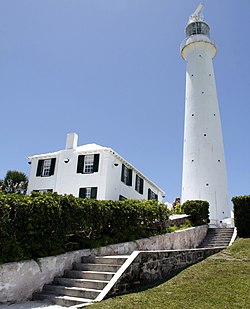Gibbs Hill Lighthouse
| Gibbs Hill Lighthouse | |||
| Main Island | |||

| |||
| Location | |||
| Location: | 32°15’10"N, 64°50’5"W | ||
| Characteristics | |||
| Height: | 118 feet | ||
| Tower shape: | tapered cylindrical tower with balcony and lantern | ||
| Light: | Fl W 10s | ||
| Intensity: | 500,000 candela | ||
| Focal height: | 354 feet | ||
| Range: | 26 nautical miles | ||
| History | |||
| Built 1844 | |||
| First lit: | 1846 | ||
| Information | |||
Gibb's Hill Lighthouse is the taller of two lighthouses on Bermuda, the other being St David's Lighthouse. It one of the first lighthouses in the world to be made of cast-iron rather than stone. It stands on a small hill, Gibbs Hill, in the centre of the Main Island, from where it may shine out over the ocean to the south and the Great Sound to the north.
The lighthouse was built in 1844 by Cottam and Hallen of Cornwall Road in Lambeth in Surrey, at their works within sight of Waterloo Bridge[1] It was shipped to Bermuda and erected by the Royal Engineers.
The optic consists of a Fresnel lens from 1904 revolving on steel bearings. However, for most of its history, the lens revolved on a bed of 1,200 pounds of mercury. While it is certainly not extremely tall in lighthouse standards, the hill that it stands on is one of the highest on the island. The light's focal plane on Gibbs Hill Lighthouse, therefore, is at 354 feet above sea level. Aeroplanes can see its flashes from over a hundred miles away.
The lighthouse has 185 steps to the top in eight flights. Until 1964, most of the light was run by hand, but in June of that year, the whole system was automated and runs on electricity. Sixty-thousand people ascended the lighthouse in 1985, and it continues to be a popular tourist attraction.
A radar antenna for marine shipping was installed atop the lighthouse in 1987 supported on a steel space frame fixed at the original bolt locations. The radar and supporting frame were undamaged in September 2003 despite the oscillation of the tower during Hurricane Fabian. This movement caused two gallons of mercury to slop out of the lens support trough and put the light out of operation. The 1904 lens was repaired in 2004 with steel bearings to replace the mercury.
At the base of the tower is the 'Lighthouse Tea Room', a restaurant converted from the lighthouse keeper's former living quarters, where breakfast, lunch, and dinner are served daily.
Pictures
-
Gibbs Hill Lighthouse Lens
-
Trial erection in Lambeth, London in 1844
-
Internal diagram
-
A view from Gibbs Hill, 1857
-
Interior view of Gibbs Hill Lighthouse near the base
-
Interior view of Gibbs Hill Lighthouse showing the cast iron plates of the outer wall.
-
Interior view of Gibbs Hill Lighthouse looking up at a ceiling
-
View of the ocean from the top of Gibbs Hill Lighthouse
Outside links
References
- ↑ "Cast-iron lighthouse". London: The Illustrated London News. 20 April 1844. p. 260. https://link.gale.com/apps/doc/HN3100009371/ILN?u=wes_ttda&sid=bookmark-ILN&xid=651b6529.
- Rowlett, Russ: Lighthouses of Bermuda – The Lighthouse Directory (University of North Carolina at Chapel Hill)
- "Lighthouse Digest". http://www.lighthousedepot.com/lite_digest.asp?action=get_article&sk=2500&bhcd2=1273856786. Retrieved May 14, 2010.






